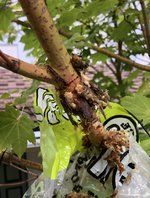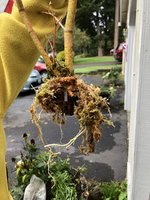Finally - Results! Sorry to drop out of this thread for awhile. Despite CV19 I was pretty busy these last months.
So the limited experimental data is out! There were some variables though, that might of confounded the initial results however.
I opened up the plastic to look at the air layer August 18. There was only the beginning of root formation, yet in all the right places.


So I buttoned the bundle up for another day. One issue I had is that I neglected to punch drain holes in the right places, so it seemed too wet overall Due to poor drainage. So I fixed that with a dinner fork.
In the next two months I observed the root extensions start to grow, then extend in the layer area all the way to the bottom of the wrap. So on Oct 20 I opened they bundle, took a photo and chopped. It seems each of the roots formed from the areas between the flaps, then took off to the top sides nearest them. Then hit the sides and each grew downwards, separate from one another. I liked that so much I saw no need to tease off the sphagnum, besides freezing weather was forecast for the next three nights! So I wanted a bit of insulation in situation. That way I know things will start wrapped before I added rest of the media.


So I decided to use 50/50 sphagnum/fine bark for the wintering over media and 1” larger bark on top. Finally pruned the +4’ long branches back to manageable size.

Finally the Pacific Fire pot was dug into one of the old frames for the winter

What did I learn?
Well.. The experiment worked in the long term, 100 days to decent root size. Yet not in 6 weeks as advertised. However, that might of been the sphagnum being too wet. In the end the roots seemed to perform as advertised though.
Next year I will try this airlayer on some other maples and azaleas (if I can keep the thin azalea bark intact). Gotta also go back and find the @Osoyoung reference to the matchstick method to compare with this method.
I redid my air airlayer on a Sango Kaku the same way at the same time as the Pacific Fire. This trial will be run all winter as the roots are not showing well.. The third I did with my wife on the same Sango Kaku. It was good enough to separate and pot on the first of Oct.
Any thoughts?
Stay safe and healthy!
Cheers
DSD sends






